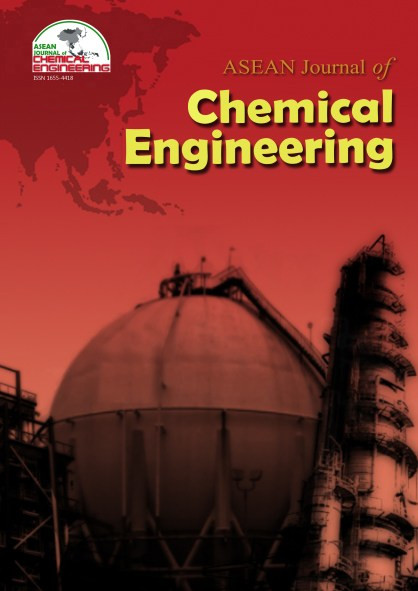Electrochemical Behaviour of Silica Deposited on Stainless Steel by Electrophoretic Deposition
Abstract
The purpose of this paper is to evaluate the characteristics of corrosion protection of stainless steel substrates coated with silica by electrophoresis with pulsed direct current (PDC) and constant direct current (CDC) with anodization. Electrophoresis was carried out using silica sol from sodium silicate solution as an electrolyte solution. Stainless steel functioned as an anode and carbon as a cathode with a constant electrode distance of 2 cm. The amplitude, duty cycle, and anodization effect on stainless steel corrosion protection characteristics were evaluated. The samples were characterized by linear polarization and electrochemical impedance spectroscopy (EIS) to see the characteristics of metal corrosion protection and scanning electron microscopy (SEM) analysis to see the morphology of the coating. This study showed that PDC electrophoresis and CDC accompanied by anodization could obtain silica film with good corrosion protection characteristics (high pore resistance and low admittance). Linear polarization results showed that metal corrosion protection behavior was increased by anodization. Similar results were obtained by EIS analysis which showed that pore resistance increased by anodization. The highest pore resistance obtained by the constant current with anodization is 543 ohms, and the lowest admittance is 0.0217. Corrosion protection characteristics are also influenced by the amplitude and duty cycle during electrophoresis. Silica film with a high pore resistance and a low admittance were obtained at a frequency, amplitude, and duty cycle of 80 Hz, 0.5 volts, and 60%, respectively. The silica film produced by pulsed electrophoresis resulted in better coating characteristics than by constant current with anodization, which is seen from the pore resistance value and its admittance.
References
Bonora, P.L., Deflorian, F., & Fedrizzi, L. 1996. “Electrochemical impedance spectroscopy as a tool for investigating underpaint corrosion.” Electrochimica Acta., 41, 1073-1082.
Castro, Y., Duran, A., Damborenea, J.J., & Conde, A., 2008. “Electrochemical behavior of silica basic hybrid coatings deposited on stainless steel by dip coating and EPD.” Electrochimica Acta, 53, 6008-6017.
Dalbin, S., Maurin, G., Nogueira, R.P., Persello, J., & Pommier, N., 2005. “Silica-based coating for corrosion protection of electrogalvanized steel.” Surface and Coatings Technology, 194, 363-371.
Li, F., Zhang, L., & Metzger, R.M., 1998. “On the growth of highly ordered pores in anodized aluminum oxide.” Chemical Materials, 10, 2470-2480.
Liu, L., 2017. “Study on the preparation of SiC coating by chemical vapor phase and the mechanical properties of ceramic matrix composites.” Chemical Engineering Transactions, 59, 115-120.
Li, X., Zhang, D., Liu, Z., Li, Z., Du, C., Dongh, C., 2015. “Materials science: share corrosion data.” Nature, 527, 441-442.
Lu, J. P., Chen, L., & Song, R. G., 2019. “Effects of SiO2 particle size on the corrosion resistance of fluoropolymer/SiO2 composite coatings.” Surface Engineering, 35, 440-449.
Marra, F., Baiamonte, L., Bartuli, C., Valente, M., Valente, T., & Pulci, G., 2016. “Tribiological behaviour of alumina-titania nanostructured coatings produced by air plasma spray technique.” Chemical Engineering Transactions, 47, 127-132.
Naim, M.N., Iijima, M., Kamiyaa, H., & Lenggoro, I.W., 2010. “Electrophoretic packing structure from aqueous nanoparticle suspension in pulse DC charging.” Colloids and Surfaces A: Physicochemical and Engineering Aspects, 360, 13-19.
Pepe, A., Galliano, P., Aparicio, M., Duran, A., & Cere S., 2006. “Sol-gel coatings on carbon steel: electrochemical evaluation.” Surface and Coatings Technology, 200, 3486-3491.
Plsko, A., Pagacova, J., Sulcova, J., Bielikova, B., Tomagova, M., Michalkov, K., & Rodova, A., 2014. “Nanocomposite films prepared from stabilized aqueous SiO2 sols.” Journal of Non-Crystalline Solids, 401, 129-133.
Suari, P., & Manulang, O., 2011. Coating steel with silica by electrophoresis to prevent corrosion, Final project, Sepuluh Nopember Institute of Technology, Surabaya, Indonesia.
Tsai, M.S., 2004. “The study of formation colloidal silica via sodium silicate.” Materials Science and Engineering: B., 106, 52-55.
Yin, Y., Zhao, H., Prabhakar, Manoj., & Rohwerder, M., 2022. “Organic composite coatings containing mesoporous silica particles: Degradation of the SiO2 leading to self-healing of the delaminated interface.” Corrosion Science., 200, 110252.
Zhou, C., Lu, X., Xin, Z., Liu, J., & Zhang, Y., 2014. “Polybenzoxazine/SiO2 nanocomposite coatings for corrosion protection of mild steel.” Corrosion Science., 80, 269-275.
Copyright holder for articles is ASEAN Journal of Chemical Engineering. Articles published in ASEAN J. Chem. Eng. are distributed under a Creative Commons Attribution-NonCommercial 4.0 International (CC BY-NC 4.0) license.
Authors agree to transfer all copyright rights in and to the above work to the ASEAN Journal of Chemical Engineering Editorial Board so that the Editorial Board shall have the right to publish the work for non-profit use in any media or form. In return, authors retain: (1) all proprietary rights other than copyright; (2) re-use of all or part of the above paper in their other work; (3) right to reproduce or authorize others to reproduce the above paper for authors’ personal use or for company use if the source and the journal copyright notice is indicated, and if the reproduction is not made for the purpose of sale.



